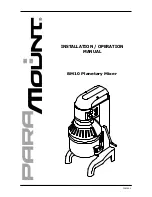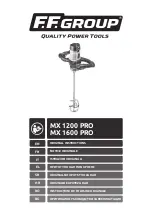
22
PA-CP
User Guide
The 16 Presets
The effects presets have been
configured to provide a variety of instantly accessible effects
types suitable for live sound mixing. Listen to each preset so
that you become familiar with how they sound. You may soon
identify a few favourites.
Power Up Memory
The effects processor remembers
the last preset selected on power down. It also remembers the
last MIDI bypass setting.
Disabling the Internal Effects
To disable the
internal processor press the SEL button to scroll through until
all the preset LEDs are turned off. This is the press after the
last preset (PHASER) is reached. To enable the effects, press
SEL again to scroll to the preset you want. You can still use an
external effects unit while the internal processor is disabled, or
use the effects return as another stereo input channel.
FOOTSWITCH
You can use a footswitch to operate the
FX channel mute function. This affects both the internal and
external effects signals. Use a switch that shorts the jack tip to
sleeve when pressed. Use a momentary switch for press-and-
hold operation, or latching for press-to-mute / press-to-unmute
operation. Note that the footswitch will have no effect if the
MUTE switch is already pressed.
☺
Using the effects
Start with the channel FX sends turned
fully off and the FX channel fader set to its normal ‘0’ position.
Make sure that FX MUTE is not selected, or the MIDI bypass
turned on. Choose one of the 16 effects presets. Raise a
channel fader to route a sound to the LR mix. Now turn up the
channel FX send control. You should start to hear the effect
adding to the sound.
Stereo effects such as reverb add ambience to the mix.
Experiment with the different presets to hear which work best
for you. Avoid the temptation to add reverb to all sounds in the
mix. For a natural sound try to add only small amounts. For
special effects higher settings can be used.
To reduce feedback and ensure clarity on stage avoid adding
reverb to the foldback monitors where possible. It is best to
use the effect on vocals and instruments such as snare drum,
woodwind, brass, acoustic guitars and keyboards. We
recommend that you do not use reverb on bass guitar, kick
drum or sources susceptible to feedback such as lecturn, stage
or radio mics. HALL is a good general purpose reverb. Short,
bright reverbs such as ROOM or PLATE can add life to vocals.
DELAY effects can add slapback or echo and are popular with
singers, particularly those covering songs from the early years.
Use the FX fader, MUTE switch, footswitch, or MIDI bypass
function to reduce or turn off the effects between songs. Use a
MIDI device such as sequencer or keyboard to remotely
change the preset type.















































